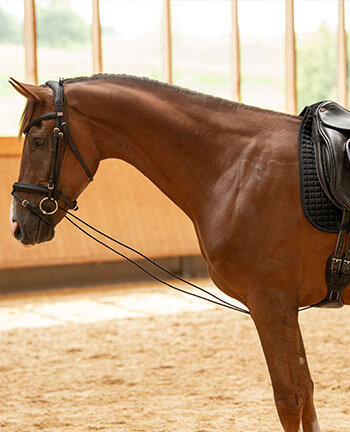Bridles & Accessories

- Frequently asked questions
- What is the difference between a bridle and a noseband?
- Which bridle is suitable for my horse?
- Which bridle should be used for a young horse?
- What are the best materials for bits?
What is the difference between a bridle and a noseband?
Often the terms bridle, noseband and headpiece are not clearly separated from each other in linguistic usage. The bridle consists of a headpiece, browband, noseband and cheek straps. A bridle can be designed for bitless riding as well as for the use of a bit.
You can buy various bridles for horses in our online shop:
- Cavesson & flash bridles
- Crank flash bridles & double bridles
- Hannover & grackle bridles
- Bitless bridles
- Mix & match systems
Our bridle accessories include:
Which bridle is suitable for my horse?
In addition to the correct buckling, the selection of the correct bridle for the horse is also crucial for horse-friendly riding. The horse's facial nerves are located close to the surface of the skin and can be easily bruised. In our shop you can buy different types of bridles that are adapted to the different head shapes of the horse.
Cavesson & flash bridles are used in almost all areas of equestrian sport. A bridle without a flash strap is called a cavesson bridle. The force is diverted to the bridge of the nose. In combination with a correctly buckled flash strap, where two fingers can be slid underneath, the bit is additionally stabilised in the mouth. This can be useful for horses that push the bit back and forth with their tongue.
Crank flash bridles are almost identical to the cavesson & flash nosebands bridles. The noseband, on the other hand, is wider and thicker padded and is buckled in the chin area by means of a pulley, which, according to studies, allows more freedom of movement. This puts less pressure on the bridge of the nose. Make sure that you do not buckle it too tightly, which can easily happen because of the pulley.
In dressage riding, double bridles are often used, which allow more sensitive aids. For this purpose, a second cheek piece is attached to the headpiece, into which the bradoon is buckled.
In contrast to the other two bridles, the noseband of the drop noseband is buckled in front of the bit and thus has a similar effect to a flash strap. It is particularly suitable for horses with a longer mouth and for horses that are sensitive.
In show jumping and eventing, the grackle noseband with the two nosebands crossing on the bridge of the nose is often used. The buckling allows the horse more freedom to breathe if done correctly.
Fine aids are also possible with a bitless bridle. It acts on the nose, the sensitive horse's mouth is spared. But be careful: In the wrong hands, especially bitless bridles with shanks can have such a strong leverage effect that it can even lead to bone fractures.
Which bridle should be used for a young horse?
The choice of the correct bridle for a young horse must be made from the combination of noseband and bit. The bit has a great influence on the young horse's mouth action or on the acceptance of the bit.
In general, bitless bridles are often used for training young horses, especially for young horses during the change of teeth. In the area of bits, single or double jointed loose ring bits in combination with a cavesson noseband are suitable for young and sensitive horses, whereby double jointed bits are to be preferred, as they allow more tongue freedom and are more comfortable in the mouth. Eggbutt bits are also used more frequently in training young horses, but are less suitable for horses that are not yet familiar with the bit. This is because the rein aids are transmitted more directly than with loose ring bits, which has a stronger effect on the tongue.
At the same time, you should pay attention to the correct size. A bit that is too long or too thick can lead to the so-called nutcracker effect. In this case, the bit stands up in the horse's mouth when the reins are pulled, presses against the palate and jams the jaws. Therefore, find the right bit for the young horse and check after some time if it still fits to make the horse as comfortable as possible. You can read more about determining the bit size in our FAQ for bits.
What are the best materials for bits?
Metal bits of any kind are the classic among bits. They are available in different alloys of copper, iron and stainless steel. Some versions of our bits are made of stainless steel and have incorporated copper pieces, which lead to quick acceptance by the horse and promote chewing activity. Some alloys contain nickel, which can cause allergic reactions on the horse's mucous membranes. Therefore, check with the manufacturer beforehand whether stainless steel bits contain nickel, so that you do not cause an allergy in the horse.
Plastic and rubber bits are currently very popular. We have bits from APPLE MOUTH in our range, which are a popular alternative to stainless steel bits. The integrated apple flavour encourages the horse to chew more, which increases suppleness and ultimately also promotes the horse's responsiveness.












